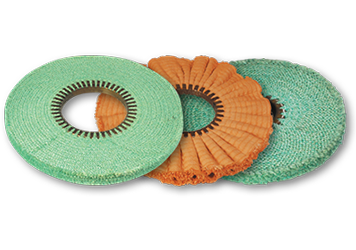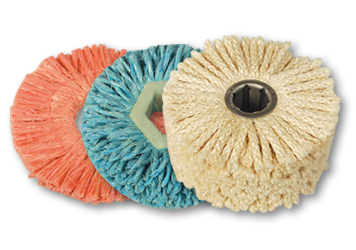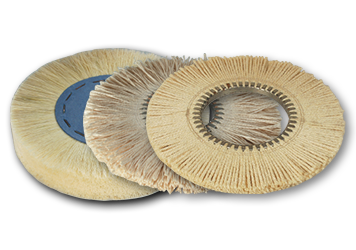Sisal
By using only first class, long sisal fibers for matting and braid, the quality of the sisal polishing tools is exceptional and guarantees a long life.
Fine Grinding and Pre-Polishing
45° Degree Material Cut
Recommended Circumference Speed
Compounds
Suggestions for the Optimal Choice of Sisal Brushes
C1/K: hollow-ware, steel, inox steel
C10/K: hollow-ware pouring lips, cooking pots, fittings, household handles
C13/K: steel tubes, automobile parts, cooking pots
C20: hollow-ware, flat surfaces
More flexible brushes are used for profiled components, for example:
C3/KU: silver-polishing, cutlery in general
C4/KU: cutlery, metal sheeting, sinks
C8/K: cutlery, handles
C11/K: knife blades, paint-scrapers
Impregnations
The correct impregnation increases longevity of the buff and enhances the polishing effect. This in turn results in cost savings on polishing buffs and compounds. A 50-100% increase in longevity is possible. All our impregnations are environmentally friendly.
Through the years of experience and continuing innovation we have developed a number of exceptional impregnations, with varying properties: fat content, stickiness, softness or high density, as can be seen below.
| Impregnation | Colour | Application | Density |
|---|---|---|---|
| No. 1 | white | for aluminium-extrusions, steel | medium |
| No. 2E3** | red | steel, stainless steel | medium firm, very conformable |
| No. 3a | brown | steel, iron, stainless steel, silver | very soft and elastic |
| No. V10 | yellow | NF metals, iron, stainless steel | medium-hard |
| No. V10/80 | yellow | NF metals, iron, stainless steel | hard to very hard |
| No. V12 | orange | stainless steel | firm to hard |
| No. V122 | orange | stainless steel | firm to hard |
| No. V23* | lilac | stainless steel, chrome, nickel | medium, sticky, elastic |
| No. V25* | green | stainless steel, iron | very hard, aggressive |
| No. V28* | yellow | aluminium, stainless steel, steel | hard, aggressive |
| No. V31** | blue | aluminium, steel | medium soft, elastic |
| No. V33** | pink | aluminium, steel | medium, elastic |
| No. V33/HK** | pink | aluminium, steel | medium, elastic, sticky |
| No. V48 | darkblue | steel, stainless | very hard |



